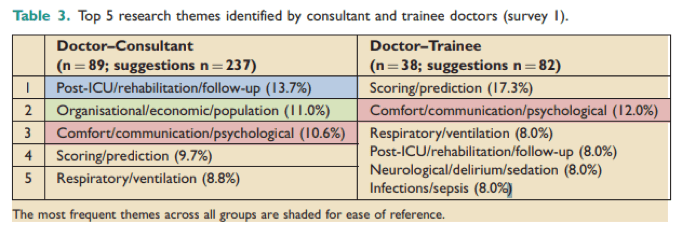Research Priorities
Most of our first projects were selected by the trainee membership at early steering committee meetings, where everything from future projects to the angle of the bird’s wings on our logo was discussed. This reflects the fact that TERN is a research network that aims to serve the needs of our members. We are interested in the perspectives of our trainees on the research questions they think clinically matter. We want to answer the questions they encounter in their everyday practice.
We know that the questions people want answered are influenced by their working practices. An analysis of the Intensive Care Society’s research prioritisation exercise with the James Lind Alliance showed a few difference between the priorities that consultants & trainees thought were most pressing.

Table from [1]
Whilst there are many common themes, the priorities demonstrate a different focus in their everyday working lives, and the priorities of consultants vary from those of their trainees. If we look at the top ten EM research priorities chosen by the Priority Setting Partnership in a similar exercise [2], we see that six of the top ten concern systems-orientated research.
This is not to say they are not important; indeed they represent some of the greatest challenges our specialty faces. However, as a trainee-orientated research network, we’re interested in helping our trainees answer more immediate questions – which patients with a thunderclap headache can be discharged with a normal CT head? What pathways for exclusion of ACS are in use within the UK and how safe are they? These are the questions our trainees need answers to on an every-day basis. The TERN Research Priorities must reflect the working practices of our trainees.
Determining priorities
Now, how do we select these priorities?
We are running a Delphi process to determine the TERN research priorities that are most important to trainees. A Delphi process is a structured group-facilitation technique exploring a problem or topic through an iterative process to determine consensus amongst invited panellists. The use of a Delphi process to determine research priorities is well described in the literature [3-5].
Delphi process
The initial questionnaire is usually designed to identify a range of issues pertinent to the topic at hand, and may involve a literature review or a process of information gathering from a wide group. We distributed a questionnaire asking for people’s research priorities, and encouraged them to put it into the part of a three-part question or PICO format. The submission period was for a month, and we spammed it across our email, Twitter, at the EMTA2020 conference, and made a post publicising it on St. Emlyn’s. My enthusiasm remained high throughout the process but I’m sure others’ waned…
We’re now in the process of refining these responses. This cleaned up initial questionnaire will be presented to the Delphi panel, who will comment on the topic and provide their thoughts. These comments are returned to the steering panel. Comments are aggregated, analysed and descriptive statistics are used to quantify central tendency (consensus) and spread (disagreement). The results of the first round and an amended questionnaire is returned to the panellists, and the process continues until consensus is broadly reached. The definitions for consensus are pre-determined during the study design. The whole process, broadly, looks like this [6]:

This process seeks to find consensus and is typically used to explore assumptions, seek expert opinion where none exists, or collect informed judgements on a topic that spans multiple disciplines. The process is anonymised and seeks to reduce some of the confounding interpersonal processes that can occur in face to face large group discussions. It can involve a geographically distributed group of people and can be done entirely remotely, which makes it well-suited for the new normal of coronavirus 2.0.
We’ll keep you updated with how this process is going, and update this page accordingly!
References
- Arulkumaran, N., Reay, H., Brett, S., JLA Intensive Care Research Priority Setting Partnership. Research priorities by professional background – A detailed analysis of the James Lind Alliance Priority Setting Partnership. J Intensive Care Soc 17(2): 111-6 (2016).
- Smith J., Keating, L., Flowerdew, L., on behalf of the JLA EM PSP Steering Group, et al. An Emergency Medicine Research Priority Setting Partnership to establish the top 10 research priorities in emergency medicine. Emergency Medicine Journal 34(7): 454-6. (2017)
- Hartshorn, S., et al. Establishing the research priorities of paediatric emergency medicine clinicians in the UK and Ireland. Emergency Medicine Journal 32(11): 864-8 (2015).
- Alshibani, A, et al. A consensus building exercise to determine research priorities for silver trauma. BMC Emergency Medicine 20(1): 63 (2020).
- Dewa, L. et al. Identifying research priorities for patient safety in mental health: an international expert Delphi study. BMJ Open 8(3): e021361 (2018).
- Hirst, R. (Delphi) Method Man. https://www.rcemlearning.co.uk/foamed/delphi-method-man/. Published 2020. Accessed December 18, 2020.
- Hirst, R. “Research, trainees and prioritisation in UK emergency medicine.,” in St. Emlyn’s, November 18, 2020, https://www.stemlynsblog.org/research-trainees-and-prioritisation-in-uk-emergency-medicine/. Accessed December 18 2020.
